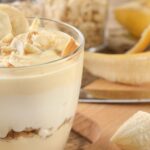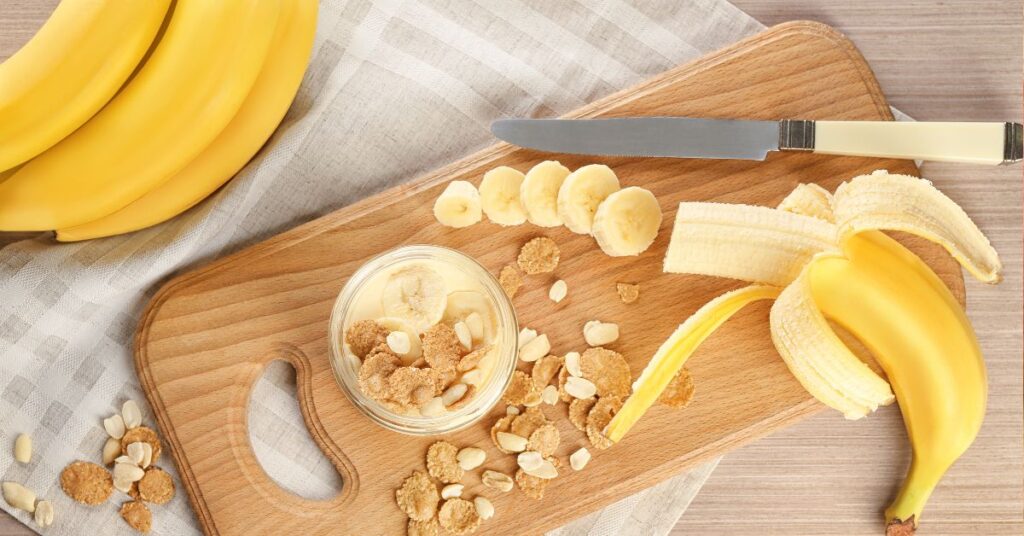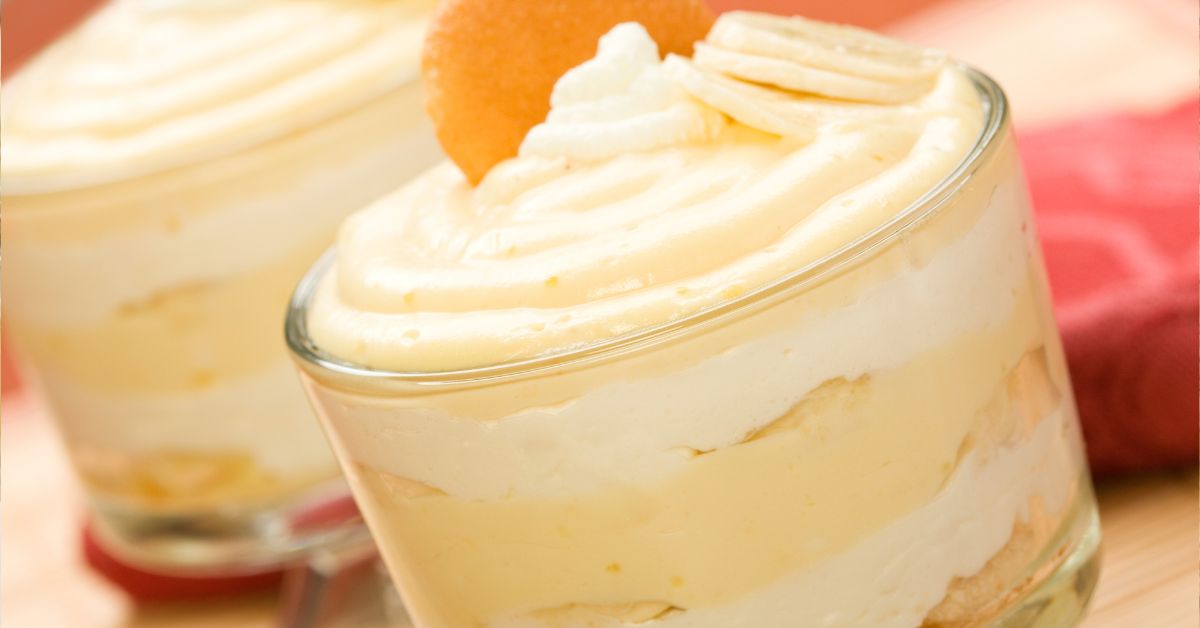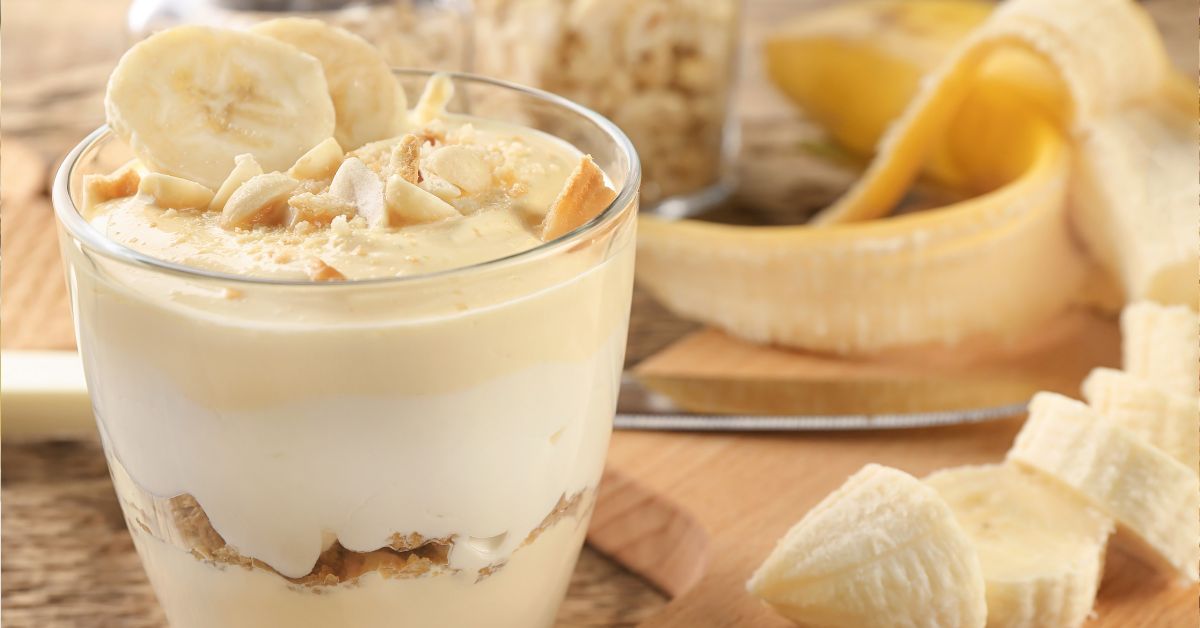Banana pudding, a dessert staple in American cuisine, especially in the South, has a rich history that intertwines with the evolution of culinary arts and cultural traditions. This delightful dessert, known for its creamy texture and sweet banana flavor, has evolved over the years, but its essence remains a comforting symbol of home-style cooking.
The Basics of Banana Pudding
Banana pudding, a quintessential comfort food, is cherished for its simplicity and the harmony of its flavors. Understanding its basic components and the contrast between traditional and modern variations is key to appreciating this classic dessert.
Key Ingredients Overview
- Bananas: The star of the dish, ripe bananas add natural sweetness and a creamy texture.
- Custard or Pudding: A blend of milk, sugar, and eggs, often thickened with flour or cornstarch, forms the base. Instant pudding mixes are a popular modern alternative.
- Vanilla Wafers: These small, crisp cookies add a delightful crunch and vanilla flavor. They soften over time, absorbing the flavors of the pudding and bananas.
- Whipped Cream or Meringue: Topping the pudding, whipped cream adds lightness, while meringue offers a traditional, toasted finish.
Traditional vs. Modern Variations
- Traditional Approach:
- Homemade Custard: Made from scratch using eggs, milk, and sugar.
- Layering: Alternating layers of vanilla wafers, sliced bananas, and custard.
- Meringue Topping: Browned in the oven for a classic finish.
- Modern Twists:
- Instant Pudding Mix: For a quicker, more convenient option.
- Creative Add-Ins: Incorporation of ingredients like peanut butter, chocolate chips, or caramel.
- Dietary Adaptations: Vegan, gluten-free, and low-sugar versions cater to various dietary needs.
- Presentation Variations: Served in individual cups, trifle bowls, or deconstructed as a parfait.
Understanding these basics lays the foundation for exploring the rich world of banana pudding, from its humble origins to the innovative creations gracing contemporary tables. Whether sticking to tradition or venturing into new culinary territories, banana pudding remains a beloved dessert, adaptable and enduring in its appeal.
Classic Banana Pudding Recipe
Embrace the comfort of this timeless dessert with a classic banana pudding recipe. Follow these step-by-step instructions to create a dish that’s both nostalgic and delicious, ensuring a perfect consistency every time.
Step-by-Step Instructions
- Prepare the Custard:
- In a medium saucepan, mix ½ cup sugar, ⅓ cup all-purpose flour, and a pinch of salt.
- Gradually stir in 3 cups of whole milk.
- Cook over medium heat, stirring constantly, until the mixture thickens and boils.
- Boil for 1 minute, then remove from heat.
- Temper the Eggs:
- In a separate bowl, beat 3 egg yolks.
- Gradually stir in a small amount of the hot milk mixture to temper the eggs.
- Then, add the tempered egg mixture back into the saucepan.
- Cook the Custard:
- Cook over low heat for 2 minutes, stirring constantly.
- Remove from heat and stir in 1 teaspoon of vanilla extract.
- Layer the Ingredients:
- In a serving dish, layer vanilla wafers, followed by sliced bananas.
- Pour a portion of the custard over the bananas.
- Repeat the layers until all ingredients are used.
- Chill the Pudding:
- Cover and refrigerate the pudding for at least 4 hours, allowing the flavors to meld and the wafers to soften.
- Add the Final Touch:
- Just before serving, spread a layer of whipped cream or meringue on top.
- Optionally, garnish with additional banana slices or crumbled wafers.
Tips for the Perfect Consistency
- Banana Ripeness: Use ripe but firm bananas to avoid them turning mushy.
- Stirring the Custard: Constant stirring prevents lumps and ensures a smooth texture.
- Layering: Allow each layer to settle before adding the next, ensuring even distribution of flavors.
- Chilling Time: Adequate chilling time is crucial for the wafers to soften and the pudding to set.
- Serving Temperature: Serve chilled for the best texture and taste.
This classic banana pudding recipe, rich in flavor and tradition, is sure to be a crowd-pleaser. By following these steps and tips, you’ll create a dessert that’s not only a treat for the taste buds but also a nod to the sweet simplicity of the past.
Innovative Twists on Traditional Banana Pudding
While the classic banana pudding is a timeless favorite, modern culinary creativity has led to some delightful variations. These innovative twists, like Banana Pudding Cheesecake, Peanut Butter Banana Pudding, and Vegan and Gluten-Free options, offer a fresh take on the traditional recipe.
Banana Pudding Cheesecake
- Ingredients:
- Vanilla wafer crust
- Cream cheese and ripe bananas for the filling
- Vanilla pudding mix and whipped cream
- Preparation:
- Create a crust using crushed vanilla wafers and butter, pressed into a springform pan.
- Blend cream cheese, mashed bananas, sugar, and vanilla extract for the filling.
- Layer the cream cheese mixture over the crust, followed by a layer of vanilla pudding.
- Chill until set and top with whipped cream and banana slices before serving.
Peanut Butter Banana Pudding
- Ingredients:
- Traditional banana pudding components
- Creamy peanut butter
- Peanut butter cookies (optional)
- Preparation:
- Prepare the classic banana pudding custard, adding creamy peanut butter to the mixture.
- Layer with vanilla wafers (or peanut butter cookies for extra flavor), sliced bananas, and the peanut butter custard.
- Refrigerate to allow the flavors to meld and serve with a dollop of whipped cream and a sprinkle of crushed peanuts.
Vegan and Gluten-Free Options
- Vegan Banana Pudding:
- Use almond milk or coconut milk in place of dairy milk.
- Substitute eggs with a vegan egg replacer or cornstarch.
- Top with dairy-free whipped cream.
- Gluten-Free Banana Pudding:
- Opt for gluten-free vanilla wafers.
- Ensure that all other ingredients, like pudding mix, are gluten-free.
- Preparation:
- Follow the traditional layering method, ensuring all substituted ingredients are well-incorporated.
- Chill and serve as usual, maintaining the classic texture and taste.
These innovative versions of banana pudding cater to diverse tastes and dietary needs, proving that this beloved dessert can continually evolve while still retaining its comforting essence. Whether you’re a cheesecake lover, a peanut butter enthusiast, or in search of a diet-friendly option, there’s a banana pudding variation just for you.
The Role of Sweetened Condensed Milk in Banana Pudding
Sweetened condensed milk is a key ingredient in many banana pudding recipes, known for its unique ability to enhance both the flavor and texture of this beloved dessert. Understanding its role and knowing how to substitute it for various dietary restrictions can help maintain the essence of banana pudding while catering to different dietary needs.
Enhancing Flavor and Texture
- Richness and Creaminess: Sweetened condensed milk adds a luxurious creaminess to banana pudding, making the texture smoother and more indulgent.
- Sweetness: It contributes a distinct, caramel-like sweetness that complements the natural flavor of bananas and the vanilla notes of the wafers and custard.
- Binding Agent: Acting as a binder, it helps in creating a cohesive mixture, ensuring that the layers of wafers, bananas, and custard meld together harmoniously.
Substitutes for Dietary Restrictions
- Lactose-Free Alternatives: Lactose-free sweetened condensed milk is available for those who are lactose intolerant, offering the same texture and flavor without the lactose.
- Vegan Options: Vegan sweetened condensed milk, made from plant-based milks like coconut milk, can be used. It provides a similar richness and sweetness but is entirely animal-free.
- Low-Sugar Variants: For those watching their sugar intake, low-sugar or sugar-free versions of sweetened condensed milk are suitable substitutes. They maintain the creamy texture while reducing the overall sweetness.
- Homemade Substitutes: A homemade version can be made by simmering a mixture of dairy or non-dairy milk and a sweetener like honey, sugar, or a sugar substitute until reduced and thickened.
Incorporating these substitutes allows for the creation of banana pudding that adheres to various dietary preferences and restrictions, ensuring that this classic dessert remains accessible and enjoyable for everyone. The key is to balance the sweetness and creaminess to replicate the traditional taste and texture of banana pudding as closely as possible.
The Debate: Baked vs. No-Bake Banana Pudding
The debate between baked and no-bake banana pudding is a testament to the dessert’s versatility and the varied preferences of its enthusiasts. Each method has its unique characteristics, pros, and cons, influenced by regional preferences and culinary traditions.
Baked Banana Pudding
- Pros:
- Rich Flavor: Baking intensifies the flavors, especially when topped with meringue, which adds a toasted, marshmallow-like taste.
- Textural Contrast: The crispy, browned top contrasts beautifully with the creamy layers beneath.
- Cons:
- More Time-Consuming: Requires additional preparation and baking time.
- Temperature Sensitivity: Overbaking can lead to curdling or a rubbery texture in the custard.
- Regional Preference: Baked banana pudding is often associated with Southern U.S. cuisine, where it’s a staple at gatherings and celebrations.
No-Bake Banana Pudding
- Pros:
- Ease and Convenience: Quicker and easier to prepare, often using instant pudding mixes and no need for an oven.
- Cool and Refreshing: Ideal for warm weather, as it’s served chilled.
- Cons:
- Less Complex Flavors: Lacks the depth of flavor that baking can impart.
- Texture: Can be overly soft or mushy if not prepared carefully.
- Variations: No-bake versions are popular in various regions and are often preferred for their simplicity and convenience.
The choice between baked and no-bake banana pudding often comes down to personal preference, occasion, and regional traditions. While the baked version offers a rich, indulgent experience, the no-bake alternative provides a quick, refreshing treat. Both styles, with their distinct qualities, ensure that banana pudding continues to be a versatile and beloved dessert.
Layering Techniques for the Perfect Banana Pudding
The art of layering is crucial in crafting the perfect banana pudding. It’s not just about aesthetics; the way you layer affects the overall texture, flavor distribution, and the interplay of ingredients.
Importance of Layering
- Flavor and Texture Balance: Proper layering ensures each spoonful has the right balance of creamy pudding, soft bananas, and crisp wafers.
- Visual Appeal: A well-layered pudding is visually enticing, showcasing the distinct layers and making it more appealing.
Creative Ideas for Presentation
- Glass Trifle Bowl: Use a large glass bowl to display the beautiful layers of your banana pudding.
- Individual Servings: Layer the pudding in mason jars or wine glasses for personalized servings.
- Deconstructed Style: Present the components separately and allow guests to build their own layers.
- Layered Parfait: Alternate the pudding, bananas, and wafers in a tall glass, topping each layer with a dollop of whipped cream.
Pairing Banana Pudding with Other Desserts
Banana pudding, with its versatile flavor profile, pairs wonderfully with a variety of other desserts. The key is to find complementary flavors and textures that enhance the overall experience.
Complementary Flavors and Textures
- Chocolate: The richness of chocolate complements the lightness of banana pudding. Consider a chocolate drizzle or chocolate shavings on top.
- Fruit Compotes: A berry compote can add a tart contrast to the sweet pudding.
- Coffee Flavors: The bitterness of coffee or espresso balances the sweetness of the pudding, making for an elegant combination.
Innovative Dessert Combinations
- Banana Pudding and Brownie Trifle: Layer chunks of fudgy brownies with banana pudding for a decadent treat.
- Banana Pudding Ice Cream Sandwiches: Use thin layers of banana pudding between cookies or wafers, then freeze.
- Banana Pudding Tiramisu: Combine the elements of tiramisu with banana pudding, using ladyfingers soaked in coffee and layering them with the pudding and bananas.
These layering techniques and dessert pairings offer creative ways to serve banana pudding, transforming it from a simple comfort food to an impressive culinary creation. Whether sticking to the classic or experimenting with new combinations, the essence of banana pudding’s delightful interplay of flavors and textures remains the heart of its appeal.
Banana Pudding for Special Occasions
Banana pudding, with its comforting appeal, can be a delightful addition to special occasions. Customizing it to fit the theme of holidays and events adds a personal touch, making it even more special.
Customizing for Holidays and Events
- Themed Decorations: For holidays like Christmas or Halloween, add themed decorations such as colored sprinkles or shaped cookies.
- Layering with Festive Ingredients: Incorporate seasonal fruits or flavored wafers to align with the occasion.
- Serving in Unique Containers: Serve in holiday-themed dishes or individual cups decorated according to the event’s theme.
Serving Sizes and Preparation Tips
- Batch Size: Estimate the serving size based on the number of guests. A standard recipe typically serves 8-10.
- Make-Ahead: Banana pudding can be made a day ahead, allowing flavors to meld and reducing last-minute prep stress.
- Transportation: If traveling, consider a no-bake version in a container with a secure lid to prevent spills.
Healthier Alternatives to Traditional Banana Pudding
Offering a healthier version of banana pudding allows everyone to indulge without guilt. These alternatives focus on reducing sugar and fat content while incorporating nutritious ingredients.
Low-Sugar and Low-Fat Options
- Reduced Sugar: Use sugar substitutes or reduce the amount of sugar in the recipe. Opt for unsweetened whipped cream as a topping.
- Low-Fat Ingredients: Substitute full-fat milk with skim or almond milk, and use low-fat or fat-free versions of condensed milk and cream cheese.
Incorporating Nutritious Ingredients
- Whole Grain Wafers: Replace traditional vanilla wafers with whole grain or oat-based cookies for added fiber.
- Additional Fruits: Alongside bananas, include berries or sliced apples for extra vitamins and a flavor twist.
- Protein Boost: Add a layer of Greek yogurt to increase protein content, which also adds a tangy contrast to the sweet pudding.
These healthier alternatives to traditional banana pudding not only cater to dietary preferences but also add a new dimension to the dessert, making it suitable for a wider audience. Whether it’s a festive gathering or a health-conscious crowd, these adaptations ensure banana pudding remains a versatile and universally loved dessert.
FAQs
What is the best type of banana to use?
- The ideal bananas for pudding are ripe yet firm. Look for bananas with yellow skins and minimal brown spots. Overripe bananas can be too mushy, affecting the texture of the pudding.
Can banana pudding be made in advance?
- Yes, banana pudding can be made in advance. It’s often recommended to prepare it at least 4 hours before serving, allowing the flavors to meld and the wafers to soften.
How to store and how long does it last?
- Store banana pudding in the refrigerator, covered tightly with plastic wrap or in an airtight container. It typically lasts for up to 3 days. The bananas may brown slightly, but it will still be tasty.
Are there any quick-fix solutions for banana pudding?
- For a quick version, use instant vanilla pudding mix, pre-made whipped cream, and store-bought vanilla wafers. Layer as usual and chill until ready to serve.
Can banana pudding be frozen?
- Freezing banana pudding is not recommended as it can alter the texture of the custard and bananas. For best results, enjoy it fresh or store it in the refrigerator.

Banana Pudding
Ingredients
Instructions
Notes
Conclusion
In this comprehensive guide, we’ve explored the delightful world of banana pudding, from its rich history and basic components to creative variations and healthier alternatives. We’ve delved into the nuances of layering, the debate between baked and no-bake versions, and how to tailor it for special occasions.
Remember, the beauty of banana pudding lies in its versatility. Don’t hesitate to experiment with different ingredients, flavors, and presentations. Whether you’re sticking to the classic recipe or trying out a modern twist, banana pudding is a canvas for culinary creativity. So go ahead, mix and match, and most importantly, enjoy the process of making and sharing this beloved dessert.


